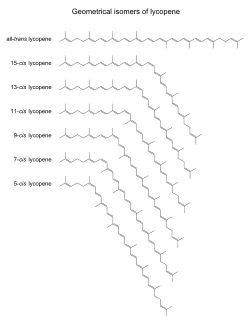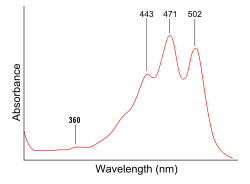Lycopene (data page)
This page provides supplementary chemical data on lycopene.
Material Safety Data Sheet
The handling of this chemical may incur notable safety precautions. It is highly recommend that you seek the Material Safety Datasheet (MSDS) for this chemical from a reliable source and follow its directions.
Structure and properties
All-trans-lycopene with canonical numbering:


Several common geometric isomers of lycopene. In total, there are 72 possible isomers of lycopene (sterically hindered isomers not included).
| Structure and properties | |
|---|---|
| Index of refraction, nD | ? |
| Dielectric constant, εr | ? ε0 at ? °C |
| Bond strength | ? |
| Bond length | ? |
| Bond angle | ? |
| Magnetic susceptibility | ? |
Spectral data
To date, no X-ray crystal structure of lycopene has been reported.

UV spectra of lycopene in hexane. A typical carotenoid, lycopene displays three absorbance maxima. A peak at 360 nm would indicate the presence of certain cis-isomers
| UV-Vis | |
|---|---|
| λmax | 443, 471, 502 nm in hexane |
| Extinction coefficient, ε | 1.72 × 105 L•mol−1•cm−1(at 502 nm)[1] |
| IR | |
| Major absorption bands | ? cm−1 |
| NMR | |
| Proton NMR | |
| Carbon-13 NMR | |
| Other NMR data | |
| MS | |
| Masses of main fragments |
|
gollark: Consult me, actually?
gollark: coralcomputationdevice
gollark: Presumably, poor-quality flash and controllers.
gollark: The majority of bees exist ambiently, but *some* bees are stored.
gollark: I am insulting you. You are offended.
References
- For hexane:CH2Cl2 98:2 v/v
Except where noted otherwise, data relate to standard ambient temperature and pressure.
Disclaimer applies.
This article is issued from Wikipedia. The text is licensed under Creative Commons - Attribution - Sharealike. Additional terms may apply for the media files.